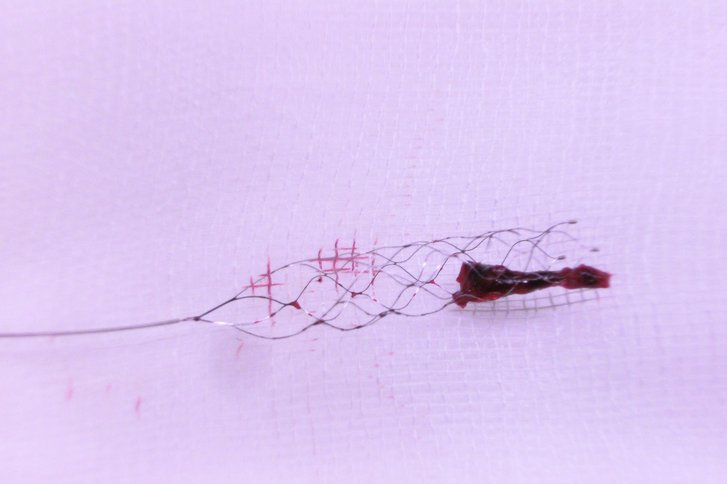In this procedure, the causative clot is mechanically removed from the diseased vessel. The Helios Hospital Krefeld is the only hospital in Krefeld to offer this new therapy option - around the clock, 365 days a year.
For a long time, the administration of medication through a vein to dissolve a clot was considered the only sufficiently proven therapy for the acute treatment of stroke. However, the size of the vascular clot is decisive for the success of treatment with drug-based thrombolysis (lysis for short). Large clots often cannot be removed in this way. However, they can lead to the most serious strokes, often resulting in permanent dependency on care or death.
Accordingly, thrombectomy is now established as the new standard of treatment in specialised stroke centres as soon as a thrombus completely blocks a large brain-supplying vessel. The vessel can then be reopened with a catheter in up to 90 percent of cases. The prerequisite for this is the use of modern catheter materials and the availability of an interdisciplinary team of doctors consisting of experienced neurologists, neuroradiologists and anaesthetists.
Thrombectomy is superior to drug thrombolysis when a large clot completely occludes a so-called main stem vessel. This is particularly bad for people who are affected, because these blockages lead to major strokes with serious consequences. The length of the thrombus that has to be dissolved is simply too long. Until now, there has been no approved therapy other than drug-based thrombolysis. However, catheter-based therapies have been used in centres in the past - until recently, however, without proven benefit. This situation has changed with the introduction of the so-called stent retriever. Scientific studies have shown that significantly more patients survive and find their way back to normal life without significant deficits.
The word thrombectomy originates from the Greek and means the mechanical removal of a blood clot from a vessel. After a detailed CT diagnosis to rule out bleeding and to detect a main stem obstruction, the decision on treatment is made: Thrombectomy is performed using catheter technology via the inguinal artery, usually under anaesthesia with X-ray control at the intervention centre. A very thin microcatheter with a diameter of less than one millimetre is pushed forward to the occluded brain vessel and through the blood clot. This contains an elastic wire mesh, the stent retriever. This wire mesh unfolds when the microcatheter is withdrawn. The blood clot is caught in it and can be pulled out and the blood flow to the brain can be restored.
Since the treatment of fresh cerebral vascular occlusion requires a great deal of experience, it belongs in the hands of experienced specialists: a neurovascular facility in which neurologists and neuroradiologists who master the complicated microcatheter techniques work closely together in a certified stroke unit.
The essential factor for a successful therapy is the time from the onset of symptoms to the start of therapy. It is important that patients are admitted to a neurovascular centre, i.e. a clinic with the appropriate professional experience and technical equipment, immediately after the onset of symptoms.
At our hospital we are able to complete the treatment from arrival at the hospital to the start of the intervention in less than 90 minutes total time. If the vascular conditions are good, the thrombectomy can then be successful within minutes - measured from the puncture of the groin into which the catheter is inserted to the extraction of the thrombus. This is an excellent performance compared to the time delays still accepted in the studies. Experts estimate that around ten percent of stroke patients are eligible for this therapy. Thrombectomy can also be used in patients who have just had surgery and are not allowed to receive clot-dissolving medication.
